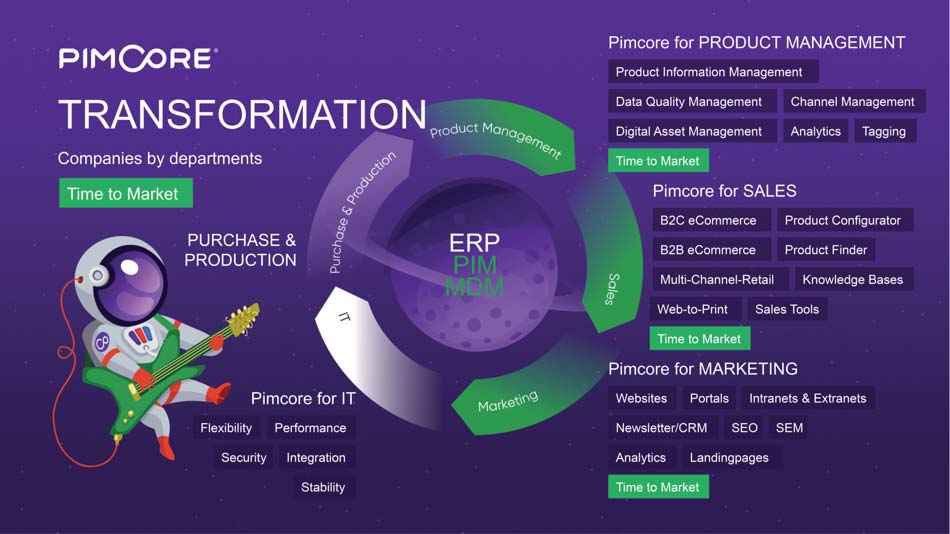How to update prices for multiple items on a website
How to change prices for multiple items?
You can use product information management systems like Pimcore to roll out price changes across multiple sites and online stores.
Using data attribution and information to update prices will save you both time and money and create efficiencies across your business.

Changing prices pose a problem
Have you got a big online store on your website? Or have you got items listed on shopping platforms like Instagram, Amazon or Google?
You’ll know how difficult it can be to keep product information up to date. One of the biggest attributes that need to be monitored and regular updates is the price. You might have an excess of product that you want to offer on sale or offer short-term flash or seasonal discounts.
You might want to try out some other pricing strategies like:
- Entry pricing strategy- where you offer products at a discount rate as an introduction to your company or the product itself
- Loss based strategy- where you connect with customers for lower price items to be able to engage them over the long term and encourage the purchase of more valuable products later
- Discounting prices- when you have surplus stock to clear or are trying to edge out a competitor
- Premium pricing- for new products which are seen as cutting edge or exclusive
But when you’ve got hundreds or thousands of prices to update, it can seem daunting to know how to go about it. This is especially true if the updated prices are offered in the short term only. The idea of doing updates individually may make it seem like it just isn’t worth the effort.
Product Information Management systems for pricing updates
There are software systems out there that enable you to roll out changes and update prices quickly and easily. Using a robust product information management system will allow you to make sure that prices are clearly displayed, are correctly updated with individual style or sizing information and are accurate to what appears in the cart.
Pimcore can be attached to your existing selling tools and trackers such as:
- Mangento
- Shopify
- Sitecore
- Salesforce
- Shopware
It can also allow integration with and optimisation for more than 2000 other selling tools and platforms. Pimcore is a system that will give you a powerful data handling tool to back up your online stores and enable you to roll out global site changes.
Monitoring and updating pricing in e-commerce
Prices are one product attributes that will probably be updated often. In volatile markets, price is always a consideration for customers. You may want to vary your prices in relation to external factors such as:
- Competitor’s prices and offerings
- Supply considerations
- Production and distribution costs
- Brand development activities
- Marketing strategies
- Customer preferences and demands
- Seasonal considerations
For most businesses, there isn’t a perfect science to pricing. And this can mean some trial and error needs to occur. Changing your prices gives you a chance to learn what marketing is working for you, and which strategies are letting you down.

Pimcore for pricing updates
If you want to roll out price changes across multiple products and on multiple sites, you will need a PIM system to process this change. With Pimcore as your PIM system, you will easily update prices across sites using initiative editing options that you can roll out across multiple products. This could be something as simple as applying a 10% discount to selected products or all the products in a range or category.
Pimcore works especially well with pricing updates when your products are on sites with different currencies. It works well in both B2B and B2C environments.
How to automate product prices online
If you have the data related to new prices existing in another location, such as in an Xcel spreadsheet, Google sheet or a CSV file, you should be able to integrate this date with your PIM using an import tool. By bringing the spreadsheet’s data into your PIM, you will be able to identify and utilise specific fields, such as price, to have the spreadsheet's contents attributed to your product in the correct field.
It is essential to ensure the file you are using has a good level of data integrity and can be considered a reliable source for your site. Errors in the data or duplication in product or price records should be flagged as the import occurs, so you can follow up on any messy records.
It’s also a good idea to run a complete back up of your existing price data before you begin a bulk price update so that if something does go wrong, you can revert to the information you had to begin with.
How to track the impact of product price changes
If you’ve gone to the effort of trying out something new, offering new marketing initiatives or discounting prices in a targeted way, you’ll want to know how effective this approach has been. The total number of sales is not the only piece of information that can give you insight into the impact of a product price change.
When you have updated a product price point- the first thing you are going to want to know the following:
- If more customers viewed the item once the price was changed. To do this you will want to track product view or views to the page
- If more customers downloaded documents related to the product- such as the instruction manual
- If customers looked at or considered customisation options by toggling product sizing or colour information
- The bounce rate- the number of customers who left your website on the page through which they entered it
- The total time on-page- to get a sense of if customers were really assessing the product or just having a fleeting look
- The number of products added to cart but not purchased
Pimcore pricing case studies
- Pimcore made it much easier for high-end fashion company Silvian Heach to manage translations and price updates across multiple sites and countries while eliminating the need for major data entry and input. Prices were managed from within the Pimcore system.
- Peugeot Motorcycles used Pimcore to update and configure pricing across five countries (France, Italy, Spain, Germany and Vietnam).
- Arduino had a data and pricing problem when the attributes associated to their products- including price, were scattered across many systems. Maintaining data in multiple sources was proving difficult and time-consuming, so they used Pimcore to create a single source of truth and create master pricing records for all of their products.
- Intersport are a European seller of sporting goods and used Pimcore to manage their extensive product catalogue, enabling quick and easy global updates to product prices, descriptions, images and other attributes while running Magento as their browser interface.
How prices are handled in Pimcore
Within its comprehensive e-commerce framework, Pimcore has a tool called Price Systems. This feature can retrieve and calculate price information, generating price information on all desired products.
With the Price Systems tool, you can apply complex pricing structures right across product catalogues. Different price source data can be used and handled to form a consistent and accurate point of truth for pricing.
Pricing rules can be configured and set to update at certain times or in certain locations. These configurations are created in the Pimcore backend by comparing different data sets and treating them within defined data hierarchy structures.
It can also handle customer-specific prices and give you information about the stock value and predicted income.
When it comes to sales time, Pimcore can also help you:
- Reduce product prices across collections and catalogues
- Add price modifiers to reduce cart totals
- Remove shipping costs
- Add gift items to purchases
- Handle discount on large and bulk orders
- Manage conditions on products sold as part of a collection or sales deal
- Send product data to different sales channels
Pricing for market segmentation
Pimcore can also help you achieve market segmentation pricing, which is a strategy through which you offer the same products to different consumers with different prices. To do this efficiently you will need to have a pretty good idea about your customer markets and segmentations.
So you will need plenty of data related to individual customers. You can use automation techniques or section profiling to distribute offers unique to individuals and customer groups. Pimcore can keep track of offers and codes that you provide to your customers, and help you ensure that every shopping experience is consistent, easy and enjoyable.
Pimcore is a brilliant asset when it comes to managing prices on your website and online stores. It can help you complete price-related actions quickly and easily, without lag or delay. It enables you to carry out quick pricing updates to any number of products in your catalogue.
If you want to create bulk purchase discounts, role or customer-specific discounts, percentage discounts or other personalise, Pimcore can help. The system is so advanced that it can manage pricing before or after a cart is loaded and give you extensive data about how your price changes benefit your business.